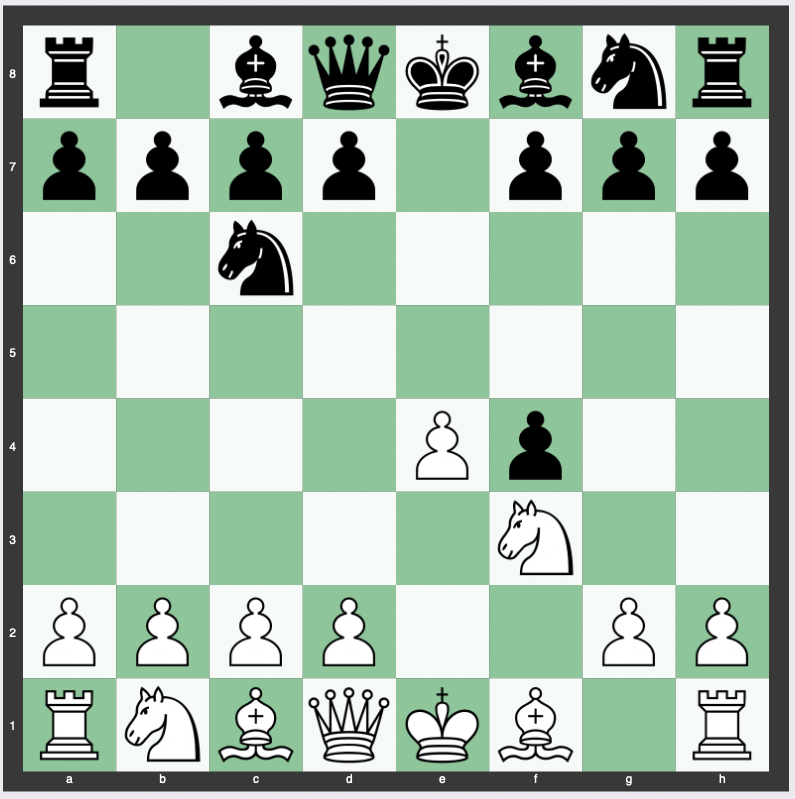The MacLeod Defense is signified by the move order 1. e4 e5 2. f4 exf4 3. Nf3 Nc6 within the context of the King’s Gambit.
The move, which is a response to the White’s opening, is considered a waiting strategy.
This means that rather than making aggressive or anticipatory moves, Black is biding their time, waiting for the right moment or for the White to make a mistake.
Creator of the MacLeod Defense
The MacLeod Defense was named after Nicholas MacLeod, a notable chess player.
Despite being a clever strategist, the Defense named after him hasn’t gained as much popularity as some other strategies, due to a few inherent issues that we’ll explore later.
Understanding the MacLeod Defense
Joe Gallagher, a prominent chess author, commented on the MacLeod Defense by stating that it “has never really caught on, probably because it does nothing to address Black’s immediate problems.”
The MacLeod Defense, as a waiting strategy, doesn’t directly counter White’s initial moves or provide an immediate benefit for Black.
Comparison with Fischer’s Defense
The MacLeod Defense shares similarities with Fischer’s Defense (1.e4 e5, 2.f4 exf4, 3.Nf3 d6).
Both are examples of waiting moves.
Yet, while Fischer’s Defense is renowned for its subtlety and unpredictability, the MacLeod Defense is often seen as passive and potentially problematic with the Nc3 move.

Drawbacks of the MacLeod Defense
An apparent drawback of the MacLeod Defense is the positioning of the knight on c6.
This placement can potentially become a target for the d-pawn later in the opening.
As a result, using this defense may put the Black player in a position of vulnerability if the White player decides to exploit this weakness.
Evaluation of the MacLeod Defense
The King’s Gambit is generally evaluated at around +0.35 to +0.05 for white.
Generally, black can get an advantage out of the King’s Gambit.
However, in this case it does not by playing 3…Nc3.
Continuation Lines of the MacLeod Defense
Some continuation lines of the MacLeod Defense include:
4. d4 g5 5. d5 g4 6. dxc6 gxf3 7. Qxf3 Qh4+ 8. g3 fxg3 9. hxg3 Qf6 10. Qb3 Qg6 11. Bg2 dxc6 12. Bf4 Bh6 13. Bxc7 Nf6 14. Nd2 O-O 15. O-O-O Bg4 16. Bf3 Bxd2+ 17. Rxd2
4. d4 g5 5. d5 g4 6. dxc6 gxf3 7. Qxf3 Qh4+ 8. g3 fxg3 9. hxg3 Qf6 10. Qb3 Qg6 11. cxb7 Qxe4+ 12. Be3 Qxb7 13. Rh4 Be7 14. Ra4 Nf6 15. Nc3 Rg8 16. O-O-O Qxb3 17. axb3 Rxg3 18. Bf4 Rg1 19. Nb5 Nd5 20. Bc4 Rxd1+ 21. Kxd1
4. d4 g5 5. d5 g4 6. dxc6 gxf3 7. Qxf3 Qh4+ 8. g3 fxg3 9. hxg3 Qf6 10. Qb3 Qg6 11. Bg2 dxc6 12. Bf4 Nh6 13. Nc3 Ng4 14. O-O-O Nf2 15. Nb5 cxb5 16. Qxb5+ c6 17. Qe5+ Be6 18. Qxh8 Nxd1 19. Rxd1 Bg4 20. Qe5+ Qe6 21. Qxe6+ fxe6 22. Rh1 Rd8
4. d4 g5 5. d5 g4 6. dxc6 gxf3 7. Qxf3 Qh4+ 8. g3 fxg3 9. hxg3 Qf6 10. cxb7 Bxb7 11. Qb3 O-O-O 12. Bf4 Bxe4 13. Rh5 Re8 14. Be2 Bb7 15. Nc3 Bd6 16. O-O-O Bxf4+ 17. gxf4 Qxf4+ 18. Kb1 Re5 19. Qa3 Ne7 20. Rxe5 Qxe5 21. Qxa7 Nc6 22. Qf2 Qe6 23. Bf3 h5 24. Bd5 Qe5
Conclusion
The MacLeod Defense, while offering a unique approach to the game with its waiting strategy, presents some notable drawbacks that can deter its use in high-stakes matches.
However, like all chess strategies, it carries potential for great reward if executed skillfully and in the right circumstances.
It serves as a testament to the depth and variety of strategies available in the ancient game of chess.
Understanding and mastering a wide range of these strategies, including the MacLeod Defense, can help players elevate their game and face any opponent with confidence.


